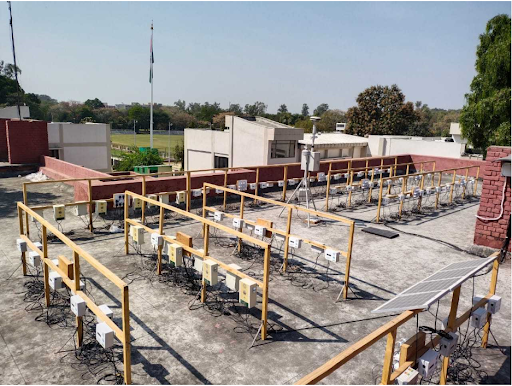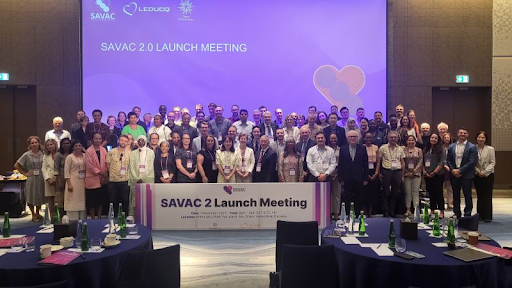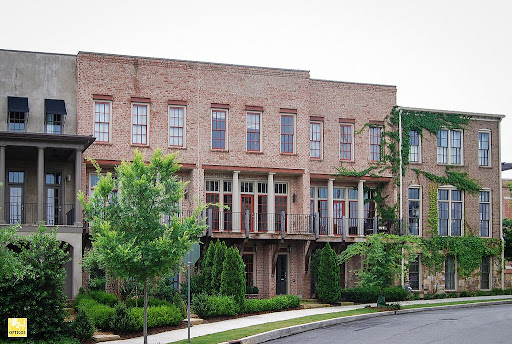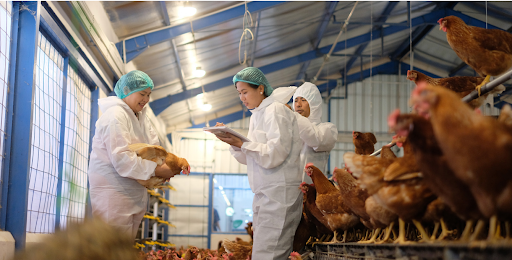Open Philanthropy’s Global Health and Wellbeing (GHW) portfolio now spans eight different programs working to improve health, raise incomes, and reduce suffering around the world. Our most recent program, global public health policy, launched in November 2023.
It can be difficult to fully grasp all the work we do within the GHW portfolio given its broad mission and wide range of programs. This blog post aims to highlight just a few updates on what our grantees accomplished in 2023, to showcase their impact and make our work a little more tangible.
For a general update on Open Philanthropy’s progress in 2023 and plans for 2024, see this blog post by our CEO Alexander Berger.
1. Global Public Health Policy
Building on our South Asian air quality work and previous grants that were recommended to us by GiveWell, we launched our Global Public Health Policy program in November 2023 with a broader scope, including lead exposure, alcohol policy, and pesticide suicide prevention. These focus areas get little attention relative to their global health burden. For example, air pollution in India and lead globally kill over 2.5 million people per year, yet likely receive under $30 million per year from philanthropic actors.
1.1 Dr. Sachchida Tripathi (air quality sensors)
Sachchida Tripathi is a professor at IIT Kanpur, one of India’s leading universities, where he focuses on civil engineering and sustainable energy.
Dr. Tripathi used an Open Philanthropy grant to purchase 1,400 low-cost air quality sensors and place them in every block[1] in rural Uttar Pradesh and Bihar. Using low-cost sensors involved procuring and calibrating them (see photo).

These sensors now provide much more accurate and reliable data for these rural areas than was previously available to the air quality community.
This work has two main routes to impact. First, these sensors make the problem of rural air pollution legible. Because air quality in India is assumed to be a largely urban issue, most ground-based sensors are in urban areas. Second, proving the value of these low-cost sensors and getting operational experience can encourage buy-in from stakeholders (e.g., local governments) who may fund additional sensors or other air quality interventions.
Air quality monitoring is a major theme of our South Asian Air Quality grantmaking. We are actively exploring opportunities in new geographic areas, both within and beyond India, without high-quality, ground-based monitoring. Santosh Harish, who leads our grantmaking on environmental health, recently spoke to the 80,000 Hours podcast about this grant as well as air quality in India more generally.
1.2 Lead Exposure Elimination Project (LEEP)
The Lead Exposure Elimination project works to end childhood lead exposure, particularly from leaded paint. They conduct paint studies to obtain country-specific data on the scale of the problem, support governments in implementing lead paint regulations, and provide technical assistance to help paint manufacturers switch to lead-free alternatives.
2023 was a big year for LEEP. In Malawi, the proportion of consumer paint that contains lead fell from 67% to 24% between 2021 and 2023 (with commitments to eliminate from several other brands) after LEEP conducted a paint study, consulted with manufacturers on reformulation, and worked with the Malawi Bureau of Standards to improve testing capacity and strengthen auditing processes. In 2023 LEEP completed seven new paint studies, and now has collaborative relationships with eighteen country governments. You can read more about their progress in 2023 and future plans in their annual review.
Progress shown by LEEP and our other two major grantees in lead exposure (Pure Earth and the Center for Global Development) was an important factor in our commitment to work on lead exposure as part of our Global Public Health Policy program. We will continue to support grantees and build collaborations to address the large and neglected burden of global lead exposure.
2. Global Health R&D
Our Global Health Research & Development program, which launched in late 2022, seeks to support the development of new vaccines, drugs, and other tools to improve global health. Health technologies like these have saved millions of lives around the world, yet relatively few exist for neglected diseases primarily affecting the world’s poorest. Further investments into developing and making accessible tools against tuberculosis, malaria, diarrheal diseases, and other diseases could prevent millions of deaths.
2.1 Cures Within Reach
Cures Within Reach was one of our first Global Health R&D grantees. They fund proof of concept, early-stage clinical trials investigating the repurposing of existing generic drugs to address new clinical indications (e.g., adding atorvastatin to the standard of care for tuberculosis, which could accelerate clearance of the disease). This strategy can reach patient impact quickly, as these drugs are already available for sale and known to be safe. While many drugs are repurposed for new indications, there are limited market incentives to do this for generic medications for diseases that affect poor people in low- and middle-income countries (LMICs).
With our grant, Cures Within Reach has selected four clinical trials to take place in LMICs, all of which will be led by principal investigators in LMICs:
- Using sodium bicarbonate to reduce maternal/fetal death from acidosis during obstructed labor in Uganda
- Testing a generic drug combination to treat acute myeloid leukemia in Tanzania
- Adding zinc to reduce sickle cell anemia–related infections in Uganda
- Adding beta-lactam to shorten Buruli ulcer disease therapy in Benin
We hope that if there are initial signs of effectiveness in these trials, these interventions will be picked up and funded in larger-scale trials. This will accelerate the use of effective, low-cost treatments (and other medical countermeasures) for diseases affecting the world’s poorest people.
This connects with Open Philanthropy’s broad approach in scientific research and global health R&D: to focus on diseases and strategies (like generic repurposing) neglected by other actors (like private industry and governments).
2.2 SAVAC
The Strep A Vaccine Global Consortium (SAVAC) is working to accelerate the development and implementation of safe and effective strep A vaccines.
Open Philanthropy is one of very few funders supporting the development of a group A strep (GAS) vaccine (we’ve funded two projects to test new vaccines). GAS kills over 500,000 people per year, mostly by causing rheumatic heart disease.[2]
While GAS is usually an uncomplicated infection causing sore throat or rash, acute rheumatic fever (especially when untreated) can lead to deadly rheumatic heart disease or death from invasive disease. Effective treatment (penicillin) exists but has not proven sufficient to address the burden of disease, especially for people in LMICs without access to treatment. Additionally, reliance on antibiotics is risky due to the development of antibiotic resistance, which means the world wants to use these tools less.

With funding from Open Philanthropy, SAVAC is preparing the world for a strep A vaccine by building a network of sentinel sites, engaging industry stakeholders, and bringing together governments and international bodies.
Focusing on GAS fits within Open Philanthropy’s approach of tackling important yet neglected areas in global health R&D. 40 million people have rheumatic heart disease, but the infection that causes it receives relatively little attention. This makes it a strong candidate for philanthropic support.
3. Scientific Research
We believe scientific progress has been, and will continue to be, one of the biggest contributors to improvements in human wellbeing, and we hope to play a part in this through our Scientific Research program. Our program officers identify scientific and engineering research that has the potential for high impact and is under-supported by other funders.
3.1 Dr. Caitlin Howell (catheters)
Caitlin Howell is an Associate Professor of Bioengineering in the Department of Chemical and Biological Engineering at the University of Maine. She runs the Howell Biointerface and Biomimetics Lab, aimed at understanding the basic science behind biological surface interactions, which have numerous medical applications. She collaborates with Dr. Ana Flores Mireles at Notre Dame University, who studies urinary tract infections.
With funding from Open Philanthropy, Dr. Howell and her team discovered an inexpensive treatment for silicon catheters to prevent microbes from developing biofilms. They presented their developments to industry developers of catheters, one of which picked up the technology in 2023. They are now moving toward regulatory approval and commercialization, which should enable widespread deployment.
Antimicrobial resistance (AMR) is a growing problem across the globe, including in low- and middle-income countries. Around 40% of AMR infections take place in hospitals, half of those from catheters alone. By stopping the formation of biofilms, this new technology could dramatically reduce the number of AMR infections (including in LMICs as it can be inexpensively deployed).
Our grants to Drs. Howell and Mireles are great examples of how, by being patient and making small bets on basic science, we can end up with big “hits” that provide solutions to high-burden problems that previously seemed intractable.
3.2 Dr. Allan Basbaum (pain research)
Allan Basbaum is Professor and Chair of the Department of Anatomy at the University of San Francisco. Dr. Basbaum is a leading academic on pain research; the Basbaum Lab explores how tissue and nerve injuries cause chronic pain.
Open Philanthropy funded Dr. Basbaum’s research to develop a method for imaging the brain and spinal cord of awake, free-moving animals. Specifically, he wanted to implant small cameras in mice that could simultaneously image the spinal cord and brain.
Other funders neglected this work, believing he would not be able to develop such a system. But with our support, Dr. Basbaum released a paper outlining how to successfully achieve the desired imaging modality, which has the potential to dramatically advance pain research.
Simultaneous imaging of the spinal cord and brain will allow researchers to better understand how the brain receives and responds to pain — a fundamental question in the field that remains unknown. Dr. Basbaum believes that this research will eventually help lead to cures for the ~20% of all people who live with chronic pain.[3]
Our grant to Dr. Basbaum highlights our hits-based giving approach to philanthropy. We are willing to make risky bets on potentially game-changing work, which allows us to fill funding gaps in neglected areas that do not fulfill the criteria of traditional funding agencies.
4. Land Use Reform
Our Land Use Reform program seeks to reduce the harms caused by excessively restrictive local land use regulations. By reducing housing costs, we can encourage economic growth, increase earnings, lower carbon emissions, and increase low-income households’ wealth and housing access.
4.1 Sightline Institute
The Sightline Institute is one of the earliest grantees within our Land Use Reform portfolio. Sightline has dedicated the past several years to advocacy on these issues in the Pacific Northwest, engaging with politicians and interest groups across the political spectrum. They’ve helped to build support for new housing, including among those concerned with social and racial justice on the left, and those focused on liberty and free markets on the right. We believe their work was important in securing a big win in 2023 when Washington state lawmakers passed two major bills on ADUs[4] (HB 1337) and middle housing[5] (HB 1110).

Removing these zoning restrictions should increase unit availability across Washington state, creating more homes that more people can afford in neighborhoods where they want to live.
Our support of Sightline fits within Open Philanthropy’s approach to advocacy and policy. This work can take years of patient advocacy, but if our grantees are successful in improving policies, even slightly, our funding can have an impact on many people at once.
5. Innovation Policy
We launched our Innovation Policy program in November 2022 to accelerate scientific and technological progress safely. Our grantmaking so far doesn’t cover the full scope of our priorities; we expect to fund many other kinds of projects in the future. But we already have updates from two grantees within the program.
5.1 Institute for Progress
The Institute for Progress (IFP) is a nonpartisan think tank based in Washington D.C. It focuses on multiple areas that Open Philanthropy is interested in, including biosecurity and innovation policy.
In September, the National Science Foundation (NSF) announced a partnership with IFP to design and execute experiments to explore how the agency funds and supports research and innovation. IFP will consult with the NSF, proposing ways to improve the scientific funding process and mechanisms to fund high-risk[6], high-reward research proposals. They will design tests of these different funding mechanisms so that the NSF and other research funders can learn more about what works.
The results of this partnership will enhance how the NSF makes investments. It will aim to reduce turnaround times on final decisions, allow greater flexibility for projects to pivot toward maximizing social benefits, and speed up real-world impact.
5.2 Institute for Replication
The Institute for Replication (I4R) systematically replicates research findings from top academic journals to improve the credibility of the social sciences.
In addition to leading over 200 completed and ongoing replications, I4R has hosted over a dozen “Replication Games” funded in part by a general support grant from Open Philanthropy. These Replication Games are one-day events that bring together skilled researchers from all levels and backgrounds to collaborate on replicating results found in top journals. Researchers work to conduct robustness checks, rerun and debug code, and discover which results hold under scrutiny. Replication results are then disseminated publicly to inform other researchers and practitioners.
Replications allow credibility and confidence in research results, but replication rates are low in academia. By supporting replications and running the Games, I4R provides an innovative approach to catalyzing, incentivizing, and disseminating replications. This enables more robust science and, downstream of that, better-informed decisions among policymakers.
6. Farm Animal Welfare
By dollars committed, Farm Animal Welfare is our largest program area within the Global Health and Wellbeing portfolio. This program supports efforts to improve the lives of animals confined on factory farms, and to end factory farming.
6.1 Open Wing Alliance
The Open Wing Alliance is a global coalition working to stop the abuse of chickens, the most numerous farmed land animal.
With support from Open Philanthropy, the Open Wing Alliance coordinates across their global network of member organizations — many of which they fund and mentor — to improve farm animal welfare worldwide.
In 2023, the alliance grew to over 100 animal welfare groups across more than 70 countries. To date, the alliance has secured 2,500+ cage-free commitments and 600+ broiler welfare policies[7] from the world’s largest corporations, 89% of which have been fulfilled.

By mobilizing their extensive network of organizations and securing these cage-free commitments, the alliance is set to improve the lives of hundreds of millions of animals.
The Open Wing Alliance’s work connects to two important themes of our farm animal welfare program: welfare campaigns for egg-laying hens and movement building. These will continue to be a focus for Open Philanthropy as we scale up our grantmaking in farm animal welfare.
6.2 Aquaculture Stewardship Council
The Aquaculture Stewardship Council (ASC) is one of the world’s largest certifiers of seafood sustainability; it sets strict standards for aquatic farming that ensure care for fish, workers, and the environment.
Open Philanthropy funded ASC to incorporate objective, evidence-based, mandatory fish welfare content into their existing standard. ASC will perform a final round of public consultation in 2024 before the standard goes into effect in 2025. Our program officers believe the new standard will meaningfully improve the welfare of billions of farmed fish.
ASC is part of Open Philanthropy’s farm animal welfare work focused on fish, the world’s most farmed animal. This grantee’s work also highlights one of our team’s strategies of working on formalized labeling and welfare standards.
7. Global Aid Policy
Our Global Aid Policy program explores approaches that could substantially increase the quantity and quality of aid and other forms of development finance. Through supporting advocacy, technical assistance, and research, we hope to increase high-income countries’ spending on aid beyond the current target of 0.7% of GNI and make it more effective.
7.1 PoliPoli
PoliPoli is a platform that connects people with politicians as well as local and central governments to enable joint policymaking, focusing on young people in Japan.
With funding from Open Philanthropy, PoliPoli launched the Reach Out Project to excite young leaders about global health and development and to support them in efforts to address major challenges in the field. The project involves supporting and coordinating young entrepreneurs’ organizations and advocacy dedicated to increasing global health aid.
Through their Reach Out Project, PoliPoli has incubated a number of successful, high-caliber organizations working on global health advocacy, many of which have captured the attention of policymakers and large media outlets. For example, Reach Out Project participant NTDs Youth was featured alongside PoliPoli’s director for 25 minutes on Nikkei and the Financial Times’ TV coverage of an infectious disease preparedness conference.[8]
PoliPoli and its incubated organizations have engaged 30 members of Japan’s parliament, as well as its health minister. PoliPoli also co-submitted a policy proposal to Japan’s Prime Minister to advocate for increased aid to cost-effective global health programs like the Global Fund, the WHO’s ESPEN project, GAVI, and the Global Financing Facility.
Open Philanthropy’s support of PoliPoli highlights our Global Aid Policy strategy of focusing on neglected donor markets. Other funders have similar programs, but they mostly focus on places like the United States, where there is already a lot of attention. Japan is the third largest donor country by dollars donated, meaning there is an opportunity that few others are addressing to direct significant resources to the highest-impact aid programs.
8. Effective Altruism (Global Health and Wellbeing)
Our Effective Altruism program empowers people to use their careers and donations to help others as much as possible. By directing people and organizations to focus on important, neglected problems and rely on evidence-based solutions, we can help them achieve much more than they otherwise would have with their resources.
8.1 Charity Entrepreneurship
Charity Entrepreneurship is an incubator for new, high-impact nonprofits. They conduct research to identify opportunities and then recruit, train, and fund talented, socially minded entrepreneurs to launch cost-effective charities.
With support from Open Philanthropy (including from our Global Catastrophic Risks team), Charity Entrepreneurship has incubated over 30 startups across multiple areas of interest, including global health, development, biorisk, and animal welfare. These startups have gone on to secure additional funding to scale their high-impact work.

By supporting Charity Entrepreneurship, Open Philanthropy has been able to grow a network of organizations to tackle large and neglected challenges in global health and development, biosafety, and farm animal welfare.
This incubation model has had some early success. For example, the Lead Exposure Elimination Project has raised nearly $3,000,000 for its successful lead paint elimination programs in 14 countries, estimated to save a child from lead exposure for under $2.
9. How you can support our grantees
These are just a small sample of the hundreds of people and organizations our Global Health and Wellbeing portfolio has supported. We are honored to support grantees as they work to improve the health and livelihood of people and animals around the world.
If you are interested in supporting this work, many of our grantees accept direct donations. Follow these links to support Lead Exposure Elimination Project, Cures Within Reach, Sightline Institute, Open Wing Alliance, and Charity Entrepreneurship. You can also find other staff recommendations for individual donors written last year here.

